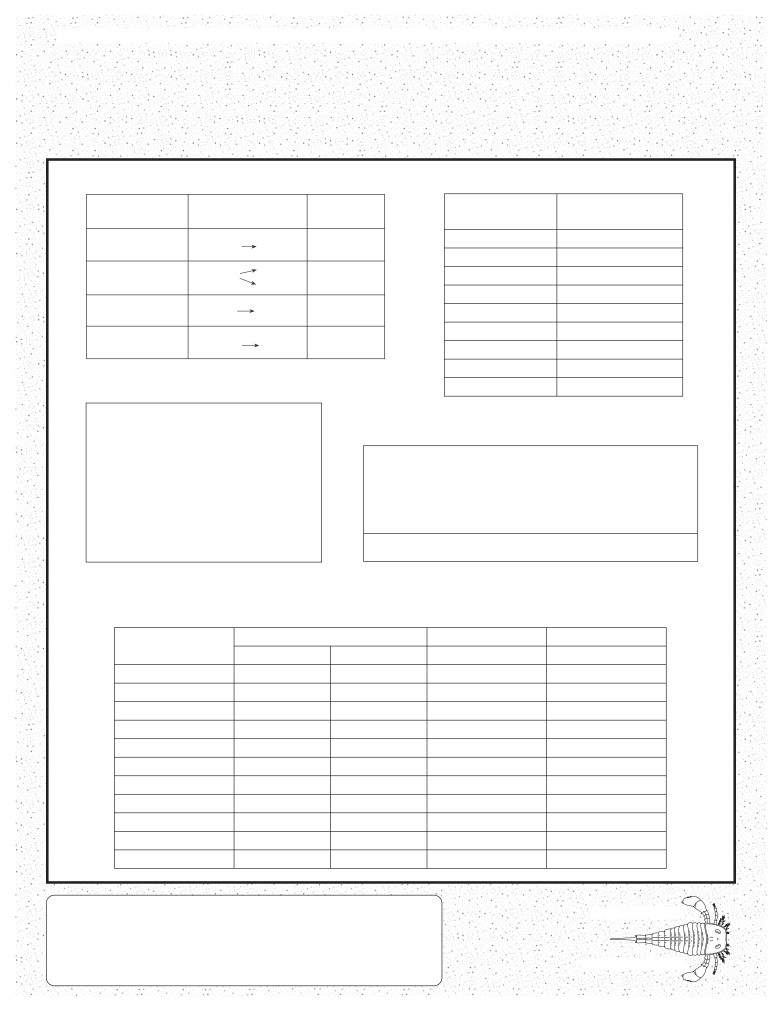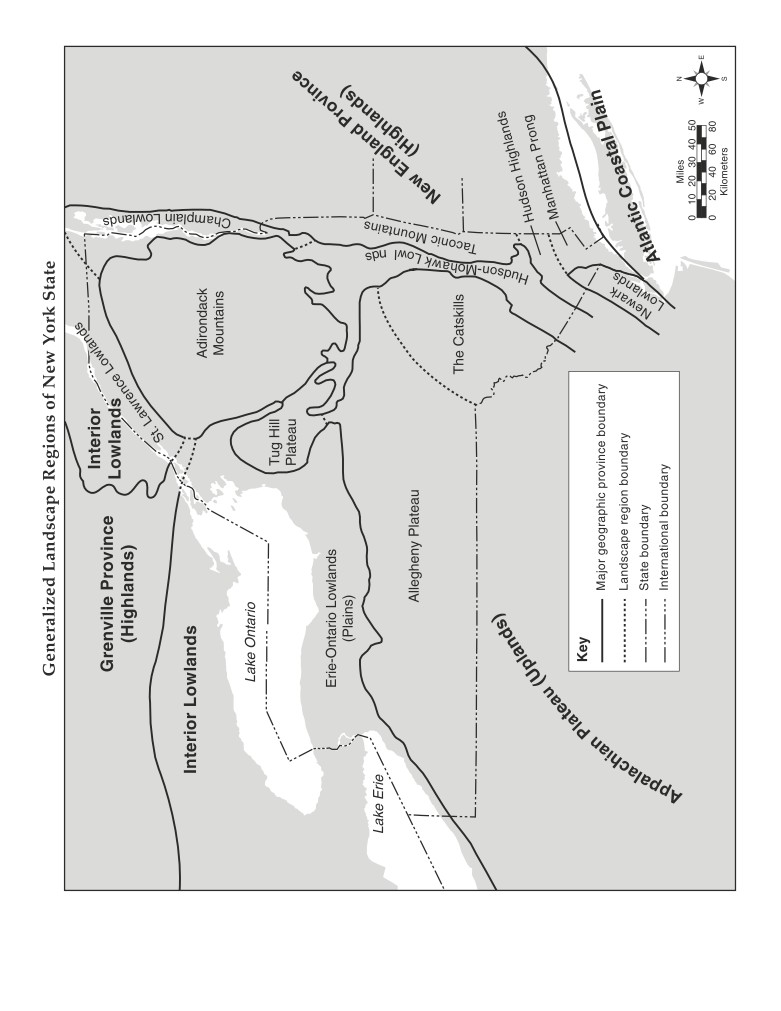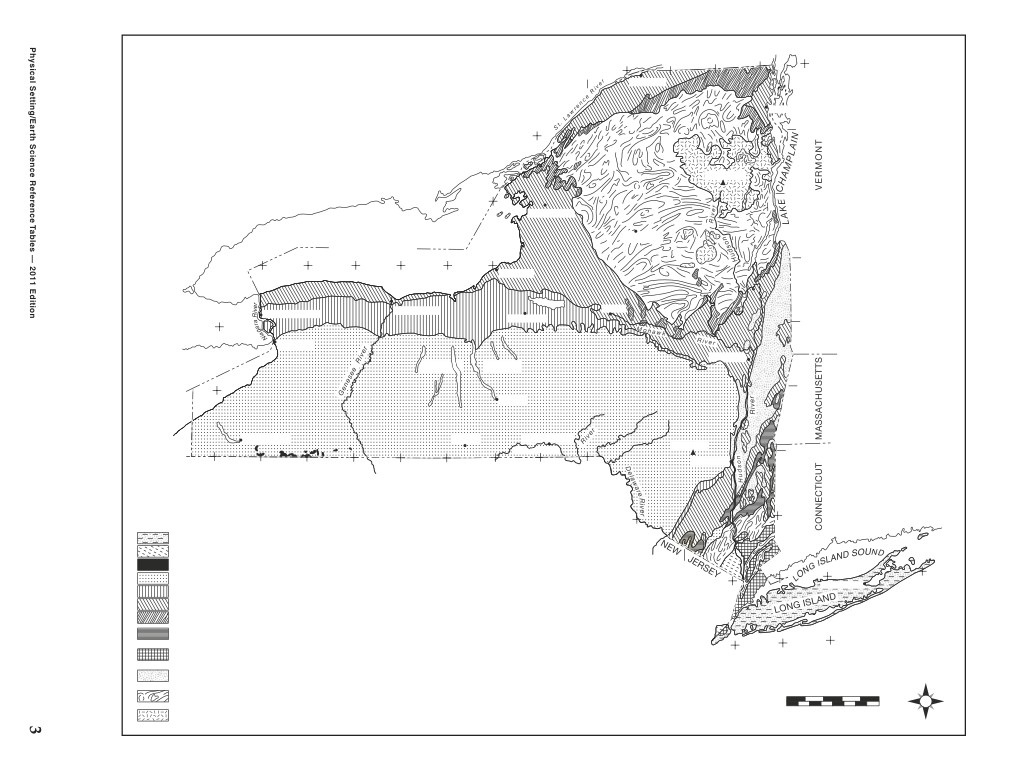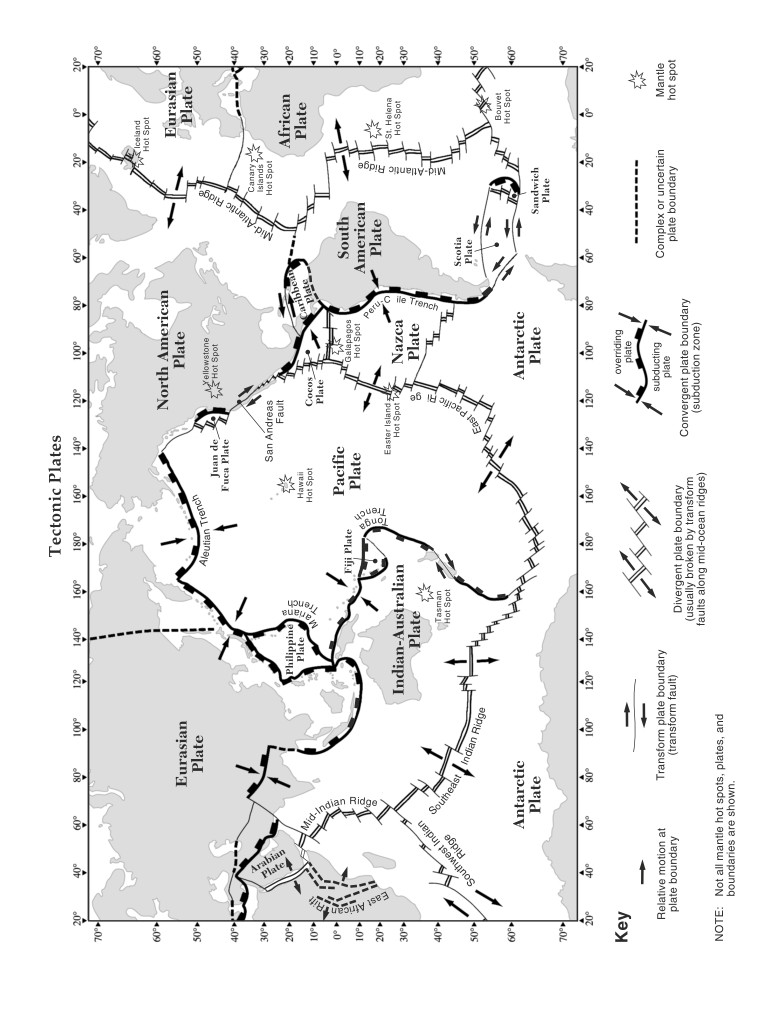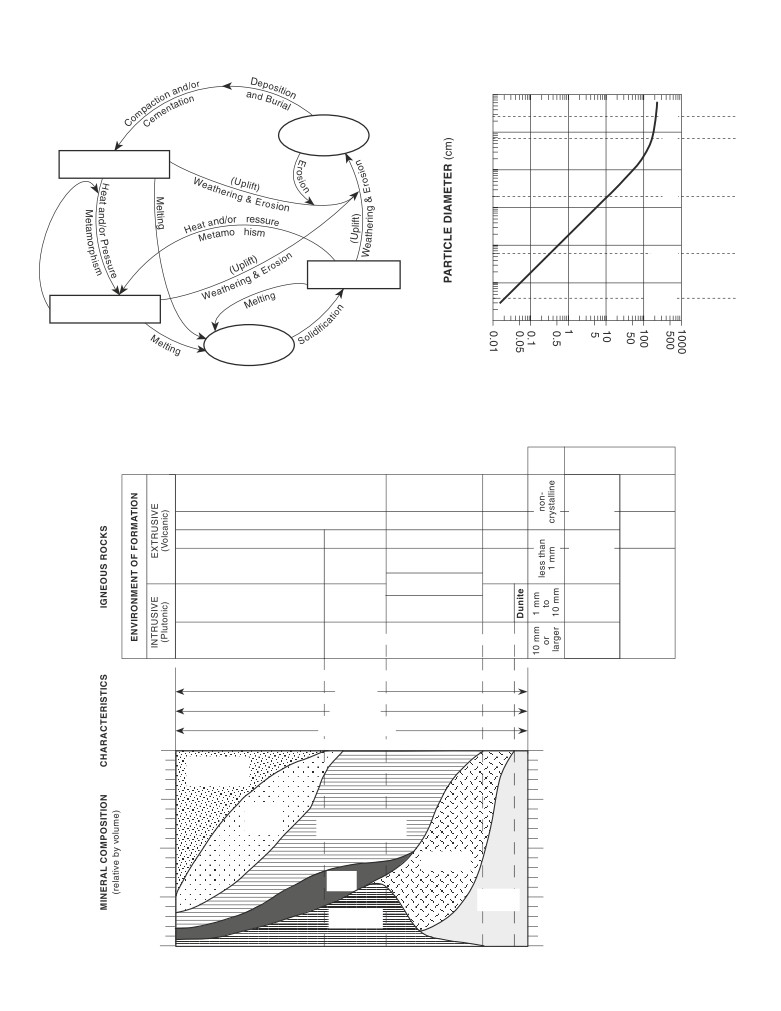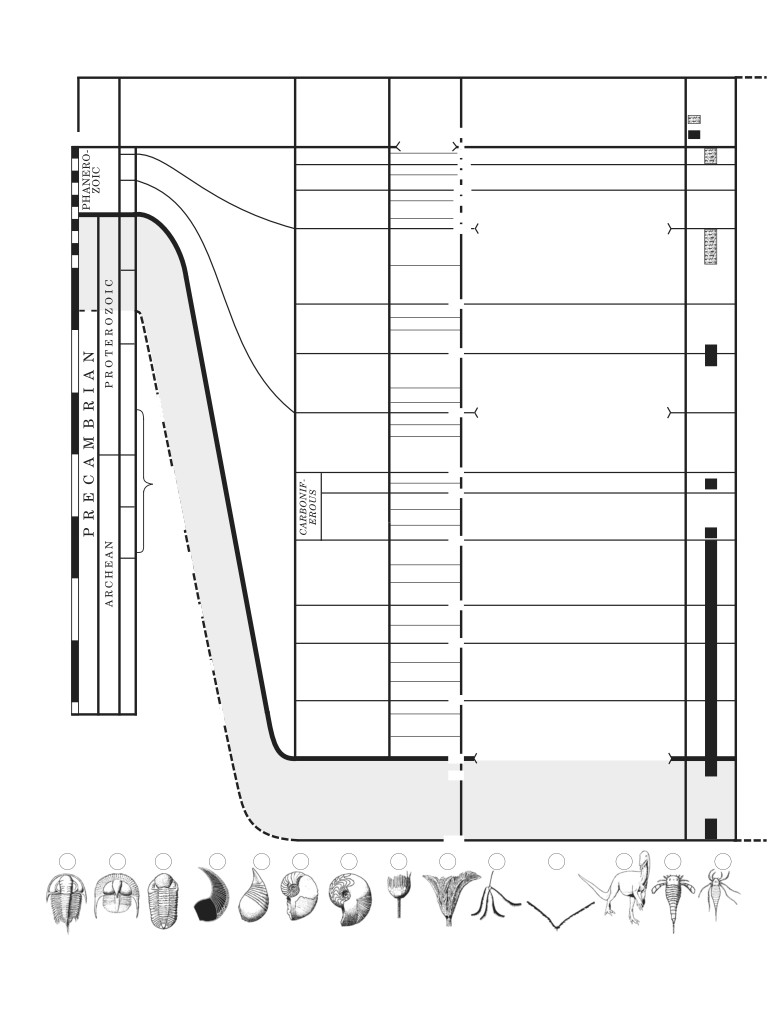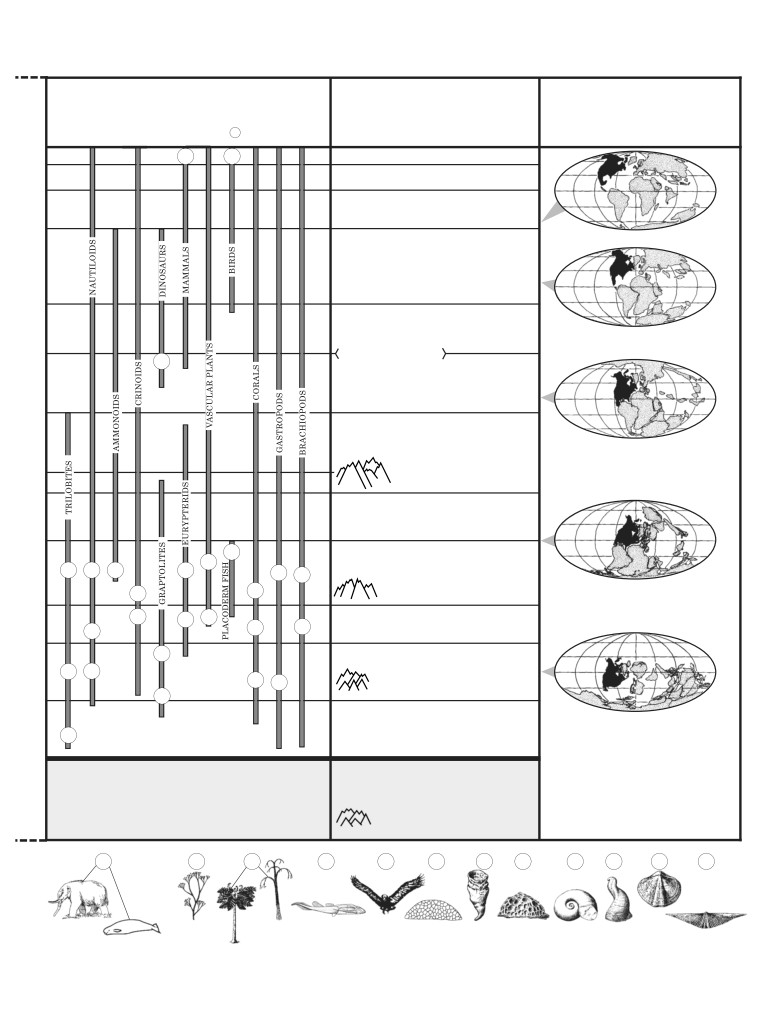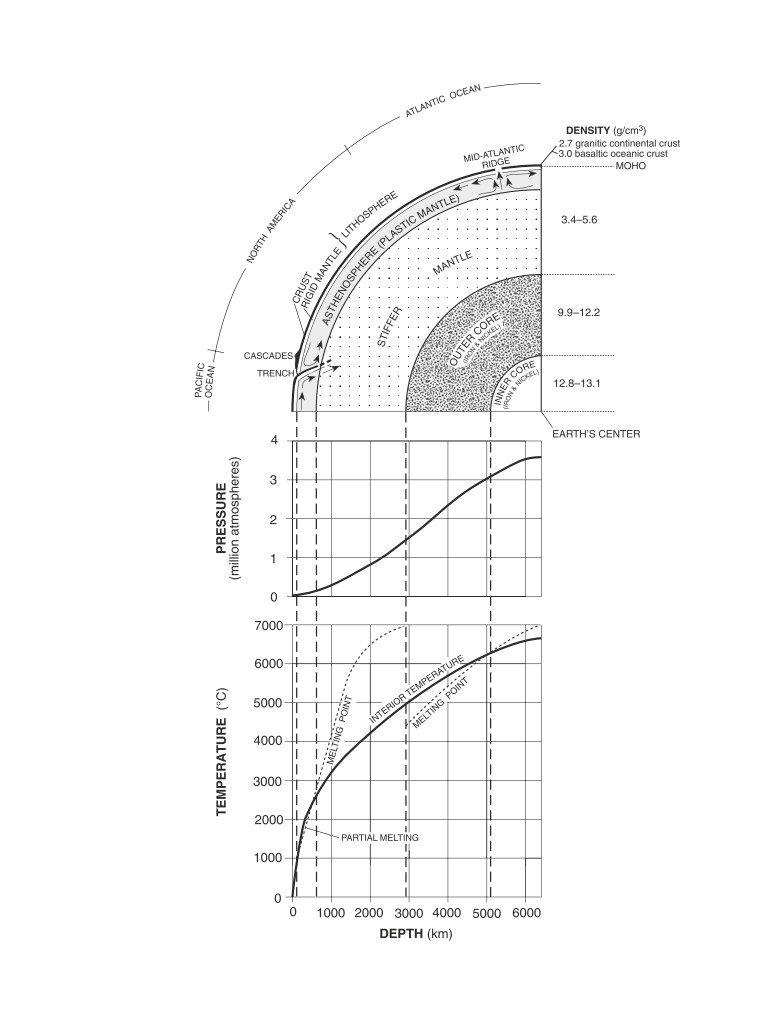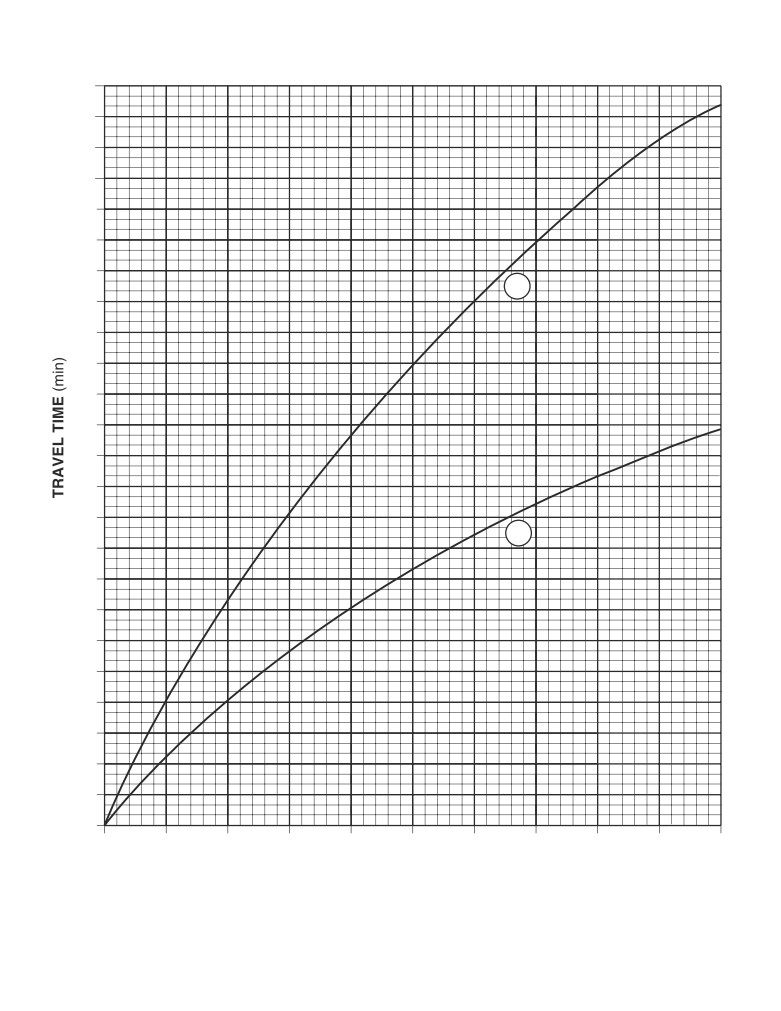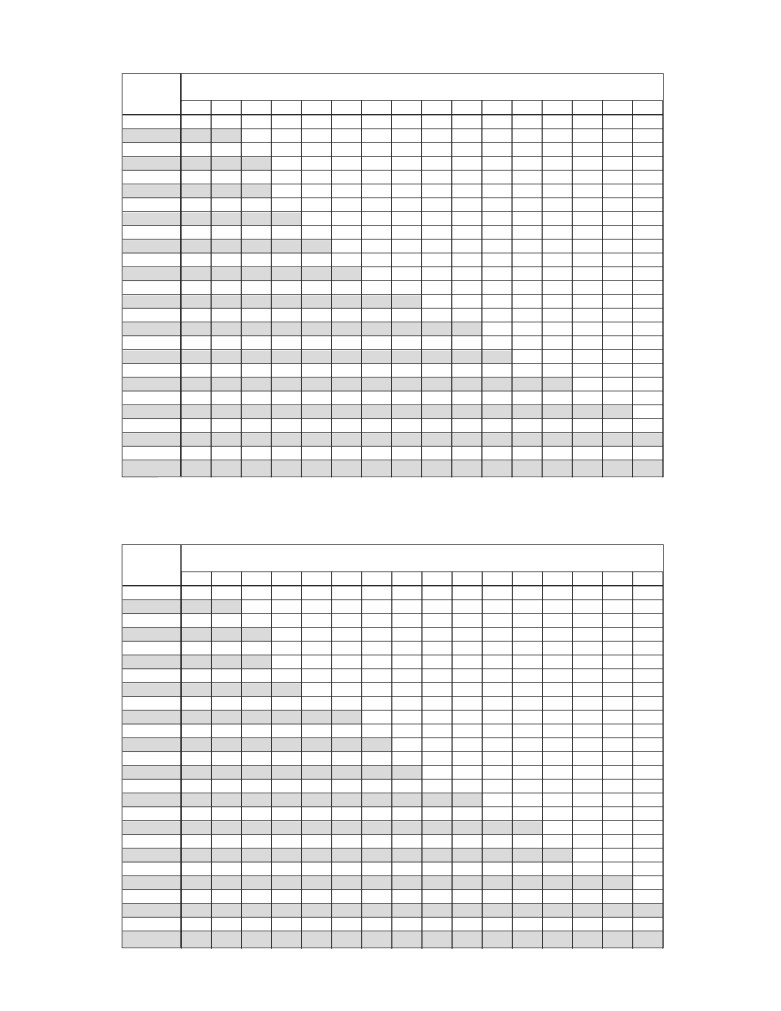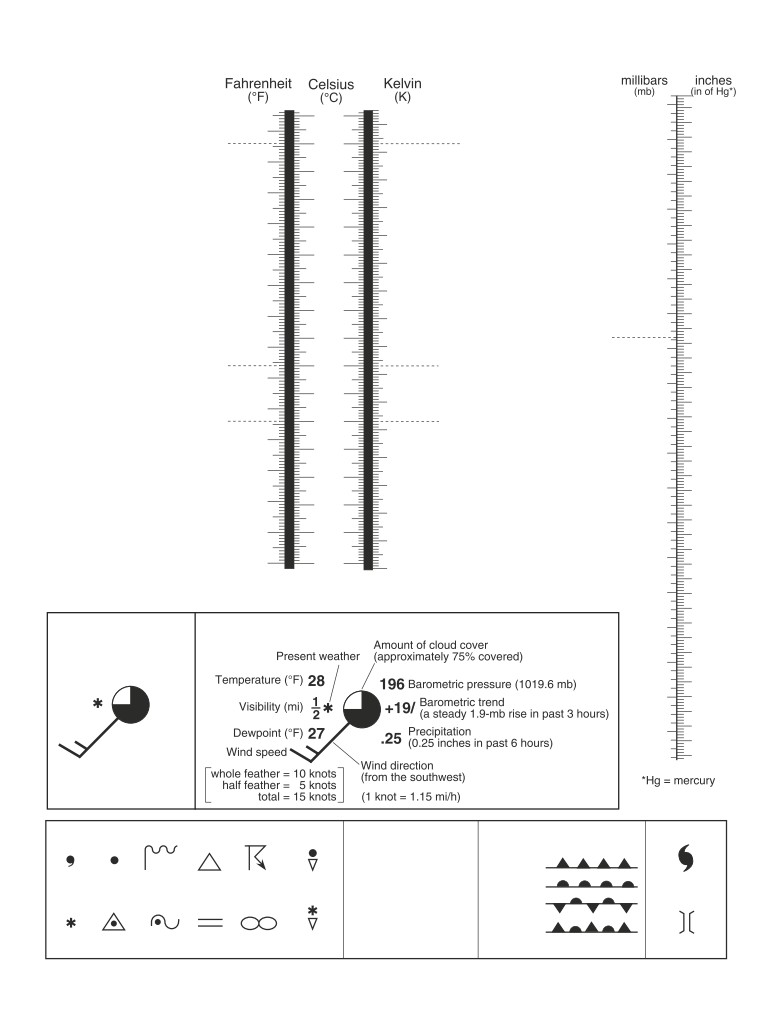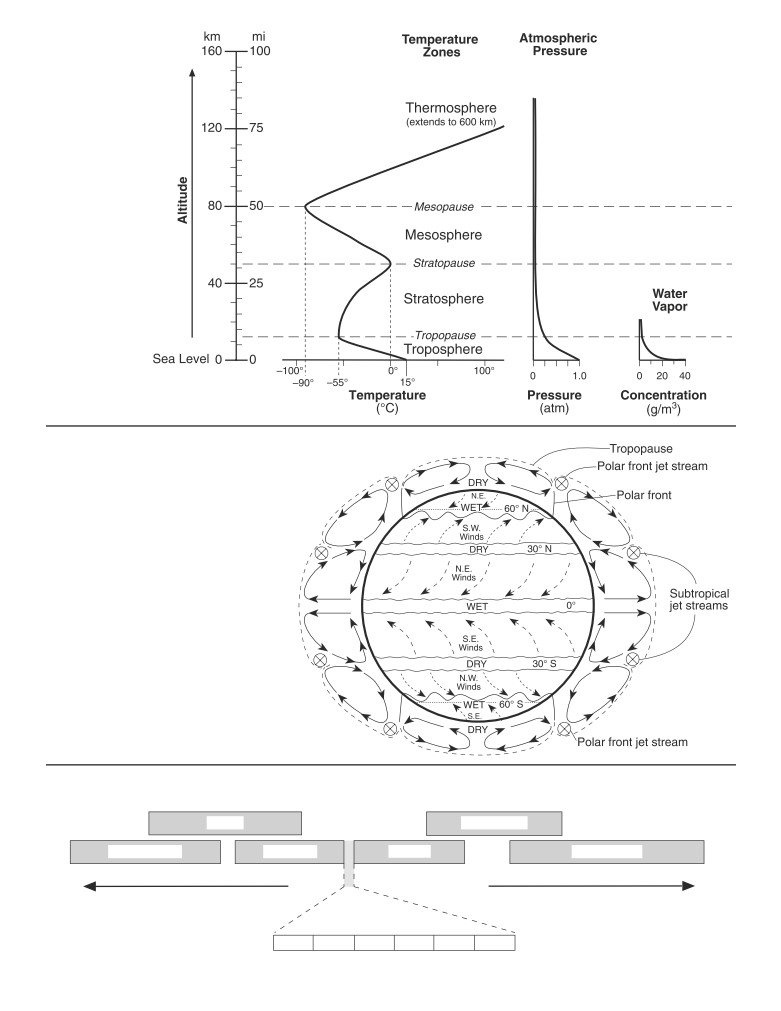The University of the State of New York • THE STATE EDUCATION DEPARTMENT • Albany, New York 12234 • www.nysed.gov
Reference Tables for
Physical Setting/EARTH SCIENCE
Radioactive Decay Data
Specific Heats of Common Materials
RADIOACTIVE
DISINTEGRATION
HALF-LIFE
MATERIAL
SPECIFIC HEAT
ISOTOPE
(years)
(Joules/gram • °C)
14
14
Liquid water
4.18
Carbon-14
C
N
5.7 × 103
Solid water (ice)
2.11
40
40
Ar
Potassium-40
K
1.3 × 109
Water vapor
2.00
40
Ca
Dry air
1.01
238
206
Uranium-238
U
Pb
4.5 × 109
Basalt
0.84
Granite
0.79
87
87
Rubidium-87
Rb
Sr
4.9 × 1010
Iron
0.45
Copper
0.38
Equations
Lead
0.13
distance between foci
Eccentricity =
length of major axis
Properties of Water
change in field value
Heat energy gained during melting
334 J/g
Gradient =
distance
Heat energy released during freezing
334 J/g
change in value
Heat energy gained during vaporization
2260 J/g
Rate of change =
time
Heat energy released during condensation . . . 2260 J/g
mass
Density =
volume
Density at 3.98°C
1.0 g/mL
Average Chemical Composition
of Earth’s Crust, Hydrosphere, and Troposphere
ELEMENT
CRUST
HYDROSPHERE
TROPOSPHERE
(symbol)
Percent by mass
Percent by volume
Percent by volume
Percent by volume
Oxygen (O)
46.10
94.04
33.0
21.0
Silicon (Si)
28.20
0.88
Aluminum (Al)
8.23
0.48
Iron (Fe)
5.63
0.49
Calcium (Ca)
4.15
1.18
Sodium (Na)
2.36
1.11
Magnesium (Mg)
2.33
0.33
Potassium (K)
2.09
1.42
Nitrogen (N)
78.0
Hydrogen (H)
66.0
Other
0.91
0.07
1.0
1.0
2011 EDITION
Eurypterus remipes
This edition of the Earth Science Reference Tables should be used in the
classroom beginning in the 2011-12 school year. The first examination for
which these tables will be used is the January 2012 Regents Examination in
New York State Fossil
Physical Setting/Earth Science.
Physical Setting/Earth Science Reference Tables — 2011 Edition
2
73°
75°
74°
45°
45°
Generalized Bedrock Geology of New York State
MASSENA
modified from
GEOLOGICAL SURVEY
PLATTSBURGH
NEW YORK STATE MUSEUM
76°
1989
MT. MARCY
44°
44°
WATERTOWN
elevation
75 m
OLD FORGE
LAKE ONTARIO
79°
78°
77°
OSWEGO
ROCHESTER
UTICA
NIAGARA
FALLS
SYRACUSE
43°
43°
BUFFALO
elevation
175 m
ALBANY
LAKE
FINGER
LAKES
ERIE
ITHACA
JAMESTOWN
ELMIRA
BINGHAMTON
SLIDE MT.
Susquehanna
42°
42°
KINGSTON
79°
78°
77°
76°
P E N N S Y L V A N I A
GEOLOGIC PERIODS AND ERAS IN NEW YORK
75°
CRETACEOUS and PLEISTOCENE (Epoch) weakly consolidated to unconsolidated gravels, sands, and clays
LATE TRIASSIC and EARLY JURASSIC conglomerates, red sandstones, red shales, basalt, and diabase (Palisades sill)
PENNSYLVANIAN and MISSISSIPPIAN conglomerates, sandstones, and shales
Dominantly
73°
41°
DEVONIAN
sedimentary
41°
limestones, shales, sandstones, and conglomerates
72°
41°
RIVERHEAD
SILURIAN
}
SILURIAN also contains salt, gypsum, and hematite.
origin
NEW YORK
ORDOVICIAN
}
CITY
limestones, shales, sandstones, and dolostones
CAMBRIAN
}
ATLANTIC OCEAN
CAMBRIAN and EARLY ORDOVICIAN sandstones and dolostones
moderately to intensely metamorphosed east of the Hudson River
40°30'
Dominantly
CAMBRIAN and ORDOVICIAN (undifferentiated) quartzites, dolostones, marbles, and schists
74°
73°30'
73°
metamorphosed
intensely metamorphosed; includes portions of the Taconic Sequence and Cortlandt Complex
rocks
Miles
TACONIC SEQUENCE sandstones, shales, and slates
}
Miles
N
slightly to intensely metamorphosed rocks of CAMBRIAN through MIDDLE ORDOVICIAN ages
0
10 20
30
40
50
0
10
20
30
40
50
MIDDLE PROTEROZOIC gneisses, quartzites, and marbles
W
E
Lines are generalized structure trends.
Intensely metamorphosed rocks
0
20
40
60
80
0
20
40
60
80
MIDDLE PROTEROZOIC anorthositic rocks
}
(regional metamorphism about 1,000 m.y.a.)
Kilometers
Kilometers
S
Physical Setting/Earth Science Reference Tables — 2011 Edition
4
h
Physical Setting/Earth Science Reference Tables — 2011 Edition
5
Rock Cycle in Earth’s Crust
Relationship of Transported
Particle Size to Water Velocity
100.0
Boulders
25.6
Cobbles
10.0
SEDIMENTS
6.4
SEDIMENTARY
ROCK
1.0
Pebbles
0.2
0.1
P
Sand
rp
0.01
0.006
IGNEOUS
Silt
ROCK
0.001
0.0004
METAMORPHIC
Clay
ROCK
0.0001
MAGMA
STREAM VELOCITY (cm/s)
This generalized graph shows the water velocity
needed to maintain, but not start, movement. Variations
occur due to differences in particle density and shape.
Scheme for Igneous Rock Identification
CRYSTAL
TEXTURE
SIZE
Non-
Obsidian
Basaltic glass
(usually appears black)
vesicular
Glassy
Pumice
Scoria
Vesicular
(gas
Vesicular rhyolite
Vesicular
Vesicular basalt
pockets)
andesite
Fine
Basalt
Rhyolite
Andesite
Diabase
Peri-
Non-
Granite
Diorite
Coarse
Gabbro
dotite
vesicular
Very
Pegmatite
coarse
LIGHTER
COLOR
DARKER
LOWER
DENSITY
HIGHER
FELSIC
MAFIC
COMPOSITION
(rich in Si, Al)
(rich in Fe, Mg)
100%
100%
Potassium
feldspar
(pink to white)
75%
75%
Quartz
(clear to
Plagioclase feldspar
white)
(white to gray)
50%
50%
Pyroxene
(green)
Biotite
(black)
25%
Olivine
25%
(green)
Amphibole
(black)
0%
0%
Physical Setting/Earth Science Reference Tables — 2011 Edition
6
Scheme for Sedimentary Rock Identification
INORGANIC LAND-DERIVED SEDIMENTARY ROCKS
TEXTURE
GRAIN SIZE
COMPOSITION
COMMENTS
ROCK NAME
MAP SYMBOL
Pebbles, cobbles,
Rounded fragments
Conglomerate
and/or boulders
embedded in sand,
Mostly
silt, and/or clay
Angular fragments
Breccia
quartz,
feldspar, and
Clastic
Sand
clay minerals;
Fine to coarse
Sandstone
(fragmental)
(0.006 to 0.2 cm)
may contain
Silt
fragments of
Very fine grain
Siltstone
(0.0004 to 0.006 cm)
other rocks
and minerals
Clay
Compact; may split
Shale
(less than 0.0004 cm)
easily
CHEMICALLY AND/OR ORGANICALLY FORMED SEDIMENTARY ROCKS
TEXTURE
GRAIN SIZE
COMPOSITION
COMMENTS
ROCK NAME
MAP
SYMBOL
Halite
Rock salt
Fine
Crystals from
to
chemical
Crystalline
Gypsum
Rock gypsum
coarse
precipitates
crystals
and evaporites
Dolomite
Dolostone
Precipitates of biologic
Crystalline or
Calcite
origin or cemented shell
Limestone
bioclastic
Microscopic to
fragments
very coarse
Compacted
Bioclastic
Carbon
Bituminous coal
plant remains
Scheme for Metamorphic Rock Identification
GRAIN
TYPE OF
TEXTURE
COMPOSITION
COMMENTS
ROCK NAME
MAP SYMBOL
SIZE
METAMORPHISM
Low-grade
Fine
Slate
metamorphism of shale
Regional
(Heat and
Foliation surfaces shiny
pressure
from microscopic mica
Phyllite
Fine
increases)
crystals
to
medium
Platy mica crystals visible
from metamorphism of clay
Schist
or feldspars
Medium
High-grade metamorphism;
to
mineral types segregated
Gneiss
coarse
into bands
Metamorphism of
Fine
Carbon
Regional
Anthracite coal
bituminous coal
Various rocks changed by
Various
Contact
Fine
heat from nearby
Hornfels
minerals
(heat)
magma/lava
Metamorphism of
Quartz
Quartzite
quartz sandstone
Fine
to
Regional
coarse
Calcite and/or
Metamorphism of
or
Marble
dolomite
limestone or dolostone
contact
Various
Pebbles may be distorted
Coarse
Metaconglomerate
minerals
or stretched
Physical Setting/Earth Science Reference Tables — 2011 Edition
7
GEOLOGIC HISTORY
NY Rock
Record
Eon
Era
Period
Epoch
Life on Earth
Sediment
Million years ago
Bedrock
Million years ago
HOLOCENE
0
0
0.01
QUATERNARY
PLEISTOCENE
Humans, mastodonts, mammoths
1.8
PLIOCENE
NEOGENE
5.3
Large carnivorous mammals
CENOZOIC
MIOCENE
Abundant grazing mammals
23.0
OLIGOCENE
Earliest grasses
33.9
500
PALEOGENE
EOCENE
Many modern groups of mammals
55.8
PALEOCENE
Mass extinction of dinosaurs, ammonoids, and
L
65.5
many land plants
A
LATE
T
MESOZOIC
E
1000
CRETACEOUS
First
Earliest flowering plants
M
EARLY
sexually
Diverse bony fishes
I
reproducing
D
organisms
146
D
LATE
Earliest birds
L
MIDDLE
Abundant dinosaurs and ammonoids
JURASSIC
E
EARLY
200
E
LATE
Earliest mammals
A
TRIASSIC
Earliest dinosaurs
2000
R
MIDDLE
Oceanic oxygen
L
begins to enter
EARLY
Mass extinction of many land and marine
251
Y
the atmosphere
LATE
organisms (including trilobites)
PALEOZOIC
MIDDLE
Mammal-like reptiles
PERMIAN
EARLY
Abundant reptiles
L
Oceanic oxygen
299
A
produced by
LATE
PENNSYLVANIAN
Extensive coal-forming forests
T
cyanobacteria
EARLY
318
E
combines with
LATE
Abundant amphibians
iron, forming
M
Large and numerous scale trees and seed ferns
3000
iron oxide layers
MISSISSIPPIAN
MIDDLE
I
(vascular plants); earliest reptiles
D
on ocean floor
EARLY
D
359
L
Earliest amphibians and plant seeds
E
LATE
Earliest stromatolites
Extinction of many marine organisms
Oldest microfossils
DEVONIAN
MIDDLE
Earth’s first forests
Earliest ammonoids and sharks
E
EARLY
Abundant fish
416
A
Evidence of biological
Earliest insects
LATE
carbon
Earliest land plants and animals
R
SILURIAN
EARLY
Abundant eurypterids
4000
L
444
Y
LATE
Oldest known rocks
Invertebrates dominant
ORDOVICIAN
MIDDLE
Earth’s first coral reefs
EARLY
488
LATE
Estimated time of origin
4600
of Earth and solar system
Burgess shale fauna (diverse soft-bodied organisms)
MIDDLE
CAMBRIAN
Earliest fishes
Extinction of many primitive marine organisms
EARLY
Earliest trilobites
542
Great diversity of life-forms with shelly parts
580
Ediacaran fauna (first multicellular, soft-bodied
marine organisms)
Abundant stromatolites
(Index fossils not drawn to scale)
1300
A
B
C
D
E
F
G
H
I
J
K
L
M
N
Cryptolithus
Valcouroceras
Centroceras
Eucalyptocrinus
Tetragraptus
Coelophysis
Stylonurus
Elliptocephala
Phacops
Hexameroceras
Manticoceras
Ctenocrinus
Dicellograptus
Eurypterus
Physical Setting/Earth Science Reference Tables — 2011 Edition
8
OF NEW YORK STATE
Time Distribution of Fossils
Important Geologic
Inferred Positions of
(including important fossils of New York)
The center of each lettered circle indicates the approximate time of
Events in New York
Earth’s Landmasses
existence of a specific index fossil (e.g. Fossil
A
lived at the end
of the Early Cambrian).
O
S
Advance and retreat of last continental ice
Sands and clays underlying Long Island and
59 million years ago
Staten Island deposited on margin of Atlantic
Ocean
Dome-like uplift of Adirondack region begins
119 million years ago
Initial opening of Atlantic Ocean
North America and Africa separate
Intrusion of Palisades sill
L
Pangaea begins to break up
232 million years ago
Alleghenian orogeny caused by
collision of North America and
Africa along transform margin,
forming Pangaea
R
Catskill delta forms
C
F G
N Q
Erosion of Acadian Mountains
X Z
Acadian orogeny caused by collision of
359 million years ago
V
North America and Avalon and closing
I
of remaining part of Iapetus Ocean
H
M P
Salt and gypsum deposited in evaporite basins
U
Y
E
Erosion of Taconic Mountains; Queenston delta
K
forms
Taconian orogeny caused by closing
B
D
of western part of Iapetus Ocean and
T W
collision between North America and
J
volcanic island arc
458 million years ago
Widespread deposition over most of New York
along edge of Iapetus Ocean
A
Rifting and initial opening of Iapetus Ocean
Erosion of Grenville Mountains
Grenville orogeny: metamorphism of
bedrock now exposed in the Adirondacks
and Hudson Highlands
O
P
Q
R
S
T
U V
W X Y
Z
Mastodont
Cooksonia
Naples Tree
Condor
Cystiphyllum
Maclurites
Eospirifer
Beluga Whale
Bothriolepis
Lichenaria
Pleurodictyum
Platyceras
Mucrospirifer
Aneurophyton
ADU (2011)
Physical Setting/Earth Science Reference Tables — 2011 Edition
9
Inferred Properties of Earth’s Interior
Physical Setting/Earth Science Reference Tables — 2011 Edition
10
Earthquake P-Wave and S-Wave Travel Time
24
23
22
21
20
19
18
S
17
16
15
14
13
12
11
10
P
9
8
7
6
5
4
3
2
1
0
0
1
2
3
4
5
6
7
8
9
10
EPICENTER DISTANCE (× 103 km)
Physical Setting/Earth Science Reference Tables — 2011 Edition
11
Dewpoint (°C)
Difference Between Wet-Bulb and Dry-Bulb Temperatures (C°)
Dry-Bulb
Tempera-
ture (°C)
0
1
2
3
4
5
6
7
8
9
10
11
12
13
14
15
– 20
- 20
- 33
–18
-18
- 28
–16
-16
- 24
–14
-14
- 21
- 36
–12
-12
-18
- 28
–10
-10
-14
- 22
–8
-8
-12
-18
- 29
–6
-6
-10
-14
- 22
–4
-4
-7
-12
-17
- 29
–2
-2
-5
-8
-13
- 20
0
0
-3
-6
-9
-15
- 24
2
2
-1
-3
-6
-11
-17
4
4
1
-1
-4
-7
-11
-19
6
6
4
1
-1
-4
-7
-13
- 21
8
8
6
3
1
-2
-5
-9
-14
10
10
8
6
4
1
-2
-5
-9
-14
- 28
12
12
10
8
6
4
1
-2
-5
-9
-16
14
14
12
11
9
6
4
1
-2
-5
-10
-17
16
16
14
13
11
9
7
4
1
-1
-6
-10
-17
18
18
16
15
13
11
9
7
4
2
-2
-5
-10
-19
20
20
19
17
15
14
12
10
7
4
2
-2
-5
-10
-19
22
22
21
19
17
16
14
12
10
8
5
3
-1
-5
-10
-19
24
24
23
21
20
18
16
14
12
10
8
6
2
-1
-5
-10
-18
26
26
25
23
22
20
18
17
15
13
11
9
6
3
0
-4
-9
28
28
27
25
24
22
21
19
17
16
14
11
9
7
4
1
-3
30
30
29
27
26
24
23
21
19
18
16
14
12
10
8
5
1
Relative Humidity (%)
Difference Between Wet-Bulb and Dry-Bulb Temperatures (C°)
Dry-Bulb
Tempera-
ture (°C)
0
1
2
3
4
5
6
7
8
9
10
11
12
13
14
15
– 20
100
28
–18
100
40
–16
100
48
–14
100
55
11
–12
100
61
23
–10
100
66
33
–8
100
71
41
13
–6
100
73
48
20
–4
100
77
54
32
11
–2
100
79
58
37
20
1
0
100
81
63
45
28
11
2
100
83
67
51
36
20
6
4
100
85
70
56
42
27
14
6
100
86
72
59
46
35
22
10
8
100
87
74
62
51
39
28
17
6
10
100
88
76
65
54
43
33
24
13
4
12
100
88
78
67
57
48
38
28
19
10
2
14
100
89
79
69
60
50
41
33
25
16
8
1
16
100
90
80
71
62
54
45
37
29
21
14
7
1
18
100
91
81
72
64
56
48
40
33
26
19
12
6
20
100
91
82
74
66
58
51
44
36
30
23
17
11
5
22
100
92
83
75
68
60
53
46
40
33
27
21
15
10
4
24
100
92
84
76
69
62
55
49
42
36
30
25
20
14
9
4
26
100
92
85
77
70
64
57
51
45
39
34
28
23
18
13
9
28
100
93
86
78
71
65
59
53
47
42
36
31
26
21
17
12
30
100
93
86
79
72
66
61
55
49
44
39
34
29
25
20
16
Physical Setting/Earth Science Reference Tables — 2011 Edition
12
Temperature
Pressure
1040.0
30.70
110
380
220
1036.0
30.60
Water boils
100
370
200
30.50
90
1032.0
360
180
30.40
80
350
1028.0
160
70
30.30
340
1024.0
140
60
30.20
330
1020.0
120
50
30.10
320
40
1016.0
30.00
100
310
30
One atmosphere
29.90
80
300
1012.0
Room temperature
20
290
29.80
60
1008.0
10
280
29.70
40
Water freezes
0
1004.0
270
29.60
20
-10
1000.0
260
29.50
0
-20
250
996.0
29.40
-20
-30
240
29.30
992.0
-40
-40
230
29.20
988.0
-60
-50
220
29.10
984.0
Key to Weather Map Symbols
29.00
Station Model
Station Model Explanation
980.0
28.90
976.0
28.80
28
196
1
972.0
28.70
+19/
2
28.60
27
968.0
.25
28.50
Present Weather
Air Masses
Fronts
Hurricane
cA
continental arctic
Cold
Drizzle
Rain
Smog
Hail
Thunder-
Rain
cP
continental polar
Warm
storms
showers
cT
continental tropical
Tornado
Stationary
mT
maritime tropical
Occluded
mP maritime polar
Snow
Sleet
Freezing
Fog
Haze
Snow
rain
showers
Physical Setting/Earth Science Reference Tables — 2011 Edition
13
Selected
Properties of
Earth’s
Atmosphere
Planetary Wind and Moisture
Belts in the Troposphere
The drawing on the right shows the
locations of the belts near the time of an
equinox. The locations shift somewhat
with the changing latitude of the Sun’s
vertical ray. In the Northern Hemisphere,
the belts shift northward in the summer
and southward in the winter.
(Not drawn to scale)
Electromagnetic Spectrum
X rays
Microwaves
Gamma rays
Ultraviolet
Infrared
Radio waves
Decreasing wavelength
Increasing wavelength
Visible light
Violet
Blue
Green
Yellow
Orange
Red
(Not drawn to scale)
Physical Setting/Earth Science Reference Tables — 2011 Edition
14
Characteristics of Stars
(Name in italics refers to star represented by a
.)
(Stages indicate the general sequence of star development.)
1,000,000
Massive
Deneb
Betelgeuse
Stars
100,000
SUPERGIANTS
Rigel
(Intermediate stage)
Spica
10,000
GIANTS
Polaris
1,000
(Intermediate stage)
Aldebaran
100
Pollux
Sirius
10
Alpha Centauri
1
Sun
0.1
40 Eridani B
0.01
Barnard’s
WHITE DWARFS
Star
(Late stage)
0.001
Procyon B
Small
Proxima
Centauri
Stars
0.0001
30,000
20,000
10,000
8,000
6,000
4,000
3,000
2,000
Surface Temperature (K)
Blue
Blue White
White
Yellow
Orange Red
Color
Solar System Data
Celestial
Mean Distance
Period of
Period of
Eccentricity
Equatorial
Mass
Density
Object
from Sun
Revolution
Rotation at Equator
of Orbit
Diameter
(Earth = 1)
(g/cm3)
(million km)
(d=days) (y=years)
(km)
SUN
—
—
27 d
—
1,392,000
333,000.00
1.4
MERCURY
57.9
88 d
59 d
0.206
4,879
0.06
5.4
VENUS
108.2
224.7 d
243 d
0.007
12,104
0.82
5.2
EARTH
149.6
365.26 d
23 h 56 min 4 s
0.017
12,756
1.00
5.5
MARS
227.9
687 d
24 h 37 min 23 s
0.093
6,794
0.11
3.9
JUPITER
778.4
11.9 y
9 h 50 min 30 s
0.048
142,984
317.83
1.3
SATURN
1,426.7
29.5 y
10 h 14 min
0.054
120,536
95.16
0.7
URANUS
2,871.0
84.0 y
17 h 14 min
0.047
51,118
14.54
1.3
NEPTUNE
4,498.3
164.8 y
16 h
0.009
49,528
17.15
1.8
EARTH’S
149.6
27.3 d
27.3 d
0.055
3,476
0.01
3.3
MOON
(0.386 from Earth)
Physical Setting/Earth Science Reference Tables — 2011 Edition
15
Properties of Common Minerals
HARD-
COMMON
DISTINGUISHING
LUSTER NESS
COLORS
CHARACTERISTICS
USE(S)
COMPOSITION*
MINERAL NAME
1-2
silver to
black streak,
pencil lead,
✔
C
Graphite
gray
greasy feel
lubricants
metallic
gray-black streak, cubic cleavage,
ore of lead,
2.5
✔
PbS
Galena
silver
density = 7.6 g/cm3
batteries
black streak,
ore of iron,
5.5
- 6.5
✔ black to
Fe3O4
Magnetite
silver
magnetic
steel
green-black streak,
ore of
6.5
✔ brassy
FeS2
Pyrite
yellow
(fool’s gold)
sulfur
5.5
- 6.5
metallic silver or
ore of iron,
✔
red-brown streak
Fe2O3
Hematite
or 1
earthy red
jewelry
white to
ceramics,
1
✔
greasy feel
Mg3Si4O10(OH)2
Talc
green
paper
2
✔ yellow to
white-yellow streak
sulfuric acid
S
Sulfur
amber
white to
easily scratched
plaster of paris,
2
✔
CaSO4• 2H2O
Selenite gypsum
pink or gray
by fingernail
drywall
colorless to
flexible in
2-2.5
✔
paint, roofing
KAl3Si3O10(OH)2
Muscovite mica
yellow
thin sheets
colorless to
cubic cleavage,
food additive,
2.5
✔
NaCl
Halite
white
salty taste
melts ice
black to
flexible in
construction
K(Mg,Fe)
2.5 - 3
✔
3
Biotite mica
dark brown
thin sheets
materials
AlSi3O10(OH)2
colorless
bubbles with acid,
cement,
3
✔
CaCO3
Calcite
or variable
rhombohedral cleavage
lime
colorless
bubbles with acid
building
3.5
✔
CaMg(CO3)2
Dolomite
or variable
when powdered
stones
colorless or
cleaves in
hydrofluoric
4
✔
CaF2
Fluorite
variable
4 directions
acid
black to
cleaves in
mineral collections,
(Ca,Na) (Mg,Fe,Al)
Pyroxene
5-6
✔
dark green
2 directions at 90°
jewelry
(Si,Al)2O6
(commonly augite)
black to
cleaves at
mineral collections,
CaNa(Mg,Fe)4 (Al,Fe,Ti)3
Amphibole
5.5
✔
dark green
56° and 124°
jewelry
Si6O22(O,OH)2
(commonly hornblende)
white to
cleaves in
ceramics,
Potassium feldspar
6
✔
KAlSi3O8
pink
2 directions at 90°
glass
(commonly orthoclase)
white to
cleaves in 2 directions,
ceramics,
6
✔
(Na,Ca)AlSi3O8
Plagioclase feldspar
gray
striations visible
glass
commonly light green
furnace bricks,
6.5
✔ green to
(Fe,Mg)2SiO4
Olivine
gray or brown
and granular
jewelry
colorless or
glassy luster, may form
glass, jewelry,
7
✔
SiO2
Quartz
variable
hexagonal crystals
electronics
often seen as red glassy grains
jewelry (NYS gem),
6.5
- 7.5
✔ dark red
Fe3Al2Si3O12
Garnet
to green
in NYS metamorphic rocks
abrasives
*Chemical symbols:
Al = aluminum
Cl = chlorine
H = hydrogen
Na = sodium
S = sulfur
C = carbon
F = fluorine
K = potassium
O = oxygen
Si = silicon
Ca = calcium
Fe = iron
Mg = magnesium
Pb = lead
Ti = titanium
✔ = dominant form of breakage
Physical Setting/Earth Science Reference Tables — 2011 Edition
16
